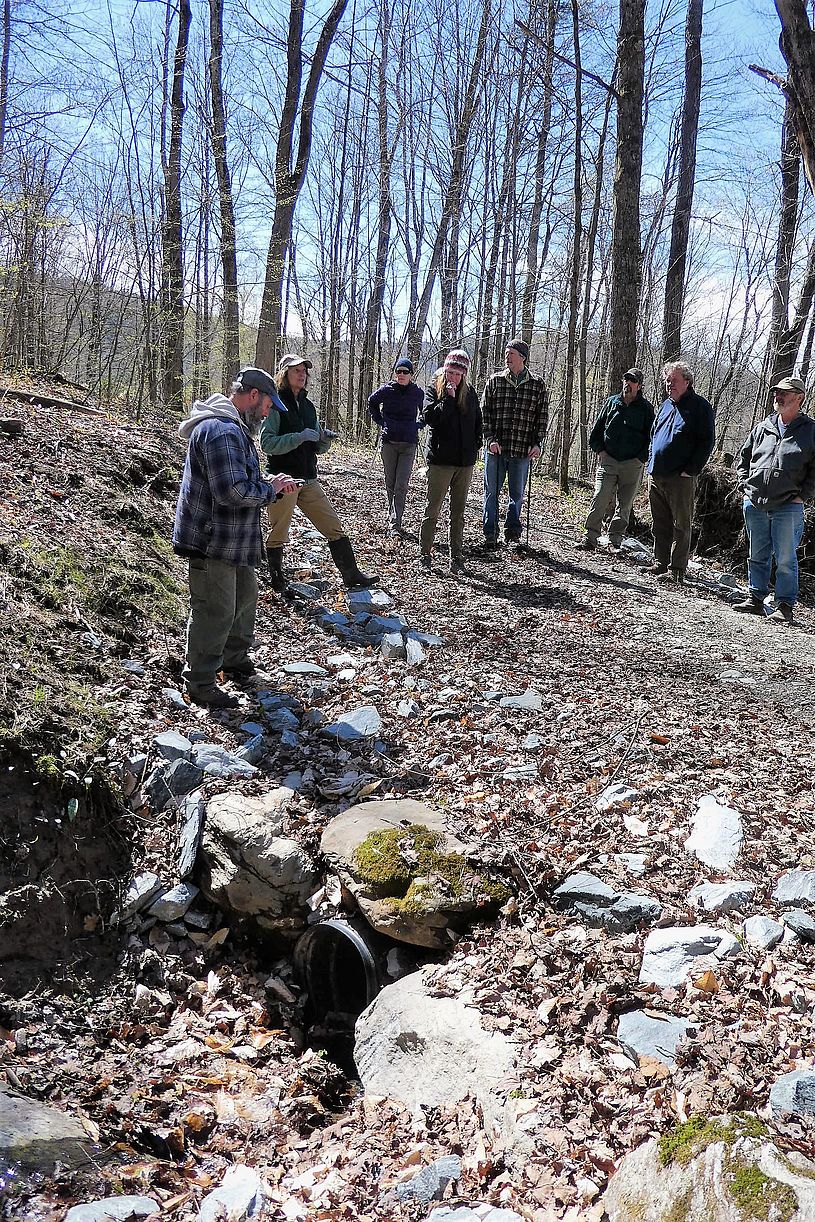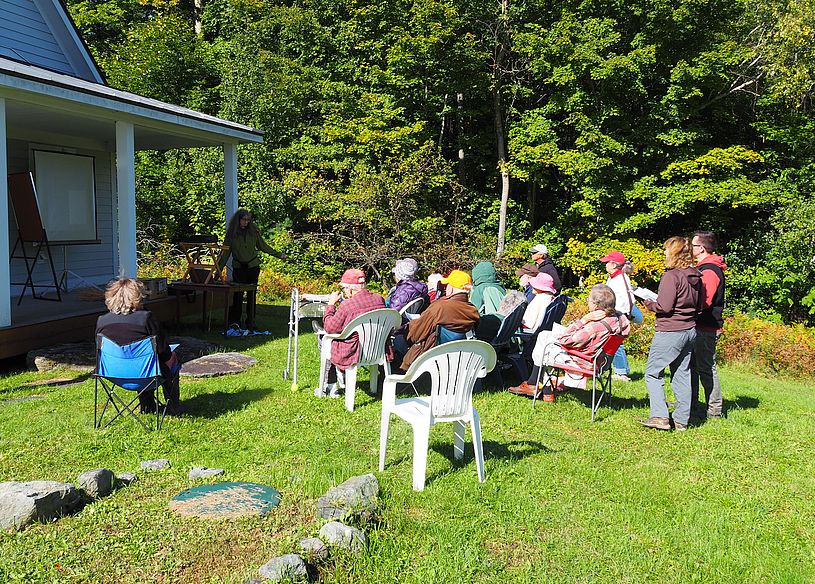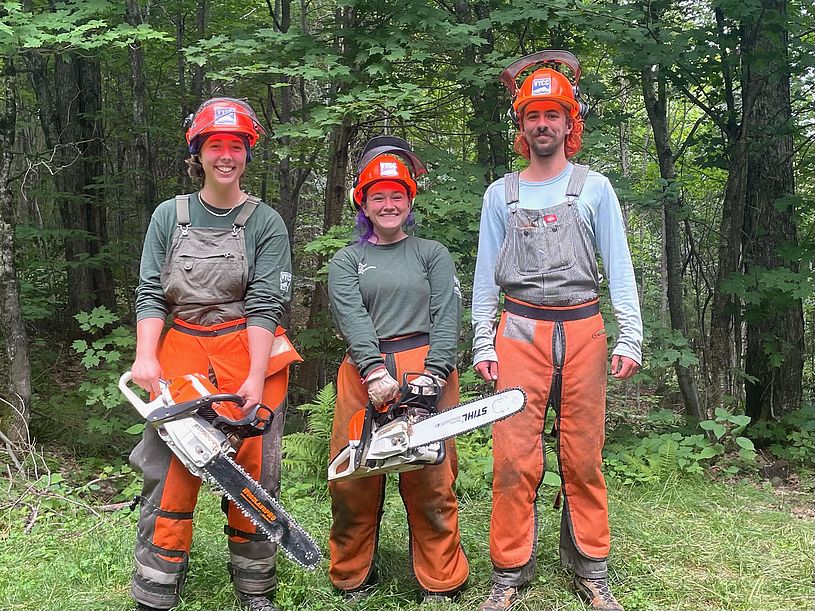Program Expenses

Expenses include:
- Staff and/or Contractor hours
- Travel hours and mileage
- Speaker fees. While CHC generally leads programs in-house or invites presenters who will be compensated through their work, we also budget to provide an honorarium for guests. Over time, this is especially important, as we have many programs and a limited number of speakers willing to donate their time and expertise.
- Costs to complete resources offered to landowners, such as Forest Songbird Habitat Assessments and Climate Change Analyses
- Printing and postage. This is mostly for new programs, to mail letters and information about programs to potential participants.
In 2021, Cold Hollow to Canada was running three "mature" programs and one new program. We were also preparing for a program that would begin in 2022. With these five programs, our expenses included (approximately):
Staff/Contract Time (approximately 10 hours per week): $20,000
Speakers: $1000
Travel & Mileage: $1000
Posting & Printing: $1000
This does not include the cost of Climate Change Analyses or Forest Bird Habitat Assessments.
In 2022, costs went up a bit as we ran the three "mature" programs and now had two new ones. Because staff time went toward Climate Change Analyses for both of the new groups, total program costs were approximately $30,000. (This includes staff time, speakers, travel/mileage, and posting/printing.)

Photo by Monica Przyperhart
To determine expected costs for starting your own program, please note that:
- There is an economy of scale in running these programs. While our Programs Directer takes 10 hours per week to run four programs, she expects that a single program would likely require an average of 5 hours per week.
- Starting a new program is more time intensive than maintaining an established program. For the first year of a program, you may want to count on spending closer to 7 hours per week, as you establish program goals and maintain a high frequency of correspondence with newly-engaged landowners. Over time, the time requirements of running a program may drop to 2-3 hours per week.
- Weekly averages are NOT distributed evenly throughout a month or year! The week or two leading up to a program (including the program itself) is most time-intensive, followed by very little time required over the next several weeks.
- At CHC, staff time is supplemented by time contributed by board members. The Programs Director is responsible for overall program administration, organization, grant tracking/fundraising, and she leads at least one field day for each program each year, but board members often volunteer their own time to lead some of the field walks.
- Every organization will need to consider appropriate staff compensation rates. Because we expect this to change over time and is dependent upon staff qualifications, we won’t post our compensation rates here, but we are happy to share this information with those who request it. In addition to time, CHC also reimburses mileage costs.
A Note on Speaker Fees
For the first year of a program, we don't generally need outside speakers! This is a chance for landowners to get to know each other and the resources partners have to offer. Once topics begin to get repetitive OR there is interest expressed for topics outside the scope of partner expertise, CHC generally offers an honorarium of $200 plus mileage for an "expert." (Note that this is 2021, and we are in a rural part of Vermont. This may or may not be an appropriate honorarium in other locations!) We also recruit grad students with an interest in presenting relevant work by providing $100 (and often a ride). If there is interest in a particular speaker who may want more compensation, we sometimes bump up our contribution, but we generally want to be sure we'll get a good audience before doing this. Some partners also offer their expertise at no cost (such as state employees). In "mature" programs, CHC generally brings in ~2 speakers per year and runs the remaining in-house, for an average speaker cost of ~$250 (including mileage) per program per year.
It is also well worth noting that Cold Hollow to Canada staff and board members are themselves experienced educators with expertise to share in the fields of forestry and natural history. We rely heavily on these individuals, particularly at the beginning of a new program. If your organization does not have this expertise to offer, you may want to invest more on speakers and bring them in earlier in a program.

Photo by Monica Przyperhart
Funding Sources
Funding sources specific to CHC’s Woodlots program include:
- The High Meadows Fund
- The Daybreak Fund
- Landscape Scale Restoration Grant (USFS)
- Open Space Institute
- Natural Resources Conservation Services, through a Regional Conservation Partnership Program grant
- A Watershed Grant (VT Fish & Wildlife) supports Toolkit Development
- Private donations through CHC’s general fundraising efforts
Alongside the funding resources mentioned above, the willingness of (and the grants obtained by) our partners to work alongside us on this program is also crucial. For CHC, songbird habitat assessments by VT Audubon (through the New England Forest and Rivers Fund) and Climate Change Analyses through the Vermont Agency of Natural Resources truly help the program succeed. A grant through the Regional Conservation Partnership Program has also allowed Woodlots landowners to be prioritized for stewardship funding through the Natural Resources Conservation Service, which gives landowners an extra incentive to remain involved.

Photo by Matt Paggi
Connecting LANDOWNERS with Funding Opportunities
One of the traits that has made the Woodlots program so appealing to landowners is that whenever possibe, CHC follows learning opportunities with funding possibilities. Forest Bird Habitat Assessments and Climate Change Analyses often leave landowners with ideas of specific management practices they would like to implement on their forest land. If a landowner would like to exapand a riparian buffer by planting new trees or release a crop tree to enhance its crown and encourage regeneration, we would like to encourage them to do so, but these non-commercial or pre-commercial practices can be expensive.
One of the primary programs that can help landowners bring down the cost of these practices is the Natural Resources Conservation Service, or NRCS. NRCS is run through the US Department of Agriculture, and they are often granted funding through federal Farm Bills to use on a variety of programs. One program, the Environmental Quality Incentives Program (EQIP), is often a good match for these non-commercial practices, and CHC can play the role of matchmaker to connect Woodlots participants with the application process and appropriate NRCS offices.
Cold Hollow to Canda has worked with the NRCS program in a more targeted capacity, too, by participating in the Regional Conservation Partnership Program, or RCPP. In 2017, CHC was the successful applicant for a 5-year RCPP. Through this grant, CHC has been able to connect Woodlots participants with ~$600,000 in funds specifically reserved for non-commercial woodland management practices. Some of these funds have been directed to updating Woodlots participants' management plans, meaning that landowners can incorporate any ideas sprouting from Forest Bird Habitat Assessments and Climate Change Analyses into their updated plans, working with a forester of their choice. Once incorporated into plans, landowners can then take the next step and once again apply for funding, this time to implement the practices identified. Examples include improved forest roads to reduce erosion, forest stand improvements to increase regeneration and structural diversity, tree planting, wildlife habitat management, early successional habitat development, improved stream crossings, and much more! This program takes considerable administration, but it has provided Woodlots participants with the financial ability to steward their land with wildlife habitat and forest resilience in mind.
As our RCPP winds to a close in 2022, CHC is actively searching for other grants that will allow us to continue offering financial assistance for stewardship practices to participating landowners. As one example, we partnered with Audubon Vermont and the Vermont Youth Conservation Corps (VYCC) in the summer of 2022, to offer VYCC's services to a landowner conducting a bird-friendly maple project at no cost. This was made possible through a grant obtained by Audubon from the New England Forest and Rivers Fund, of the National Fish & Wildlife Foundation. You can read more about this partnership here.

